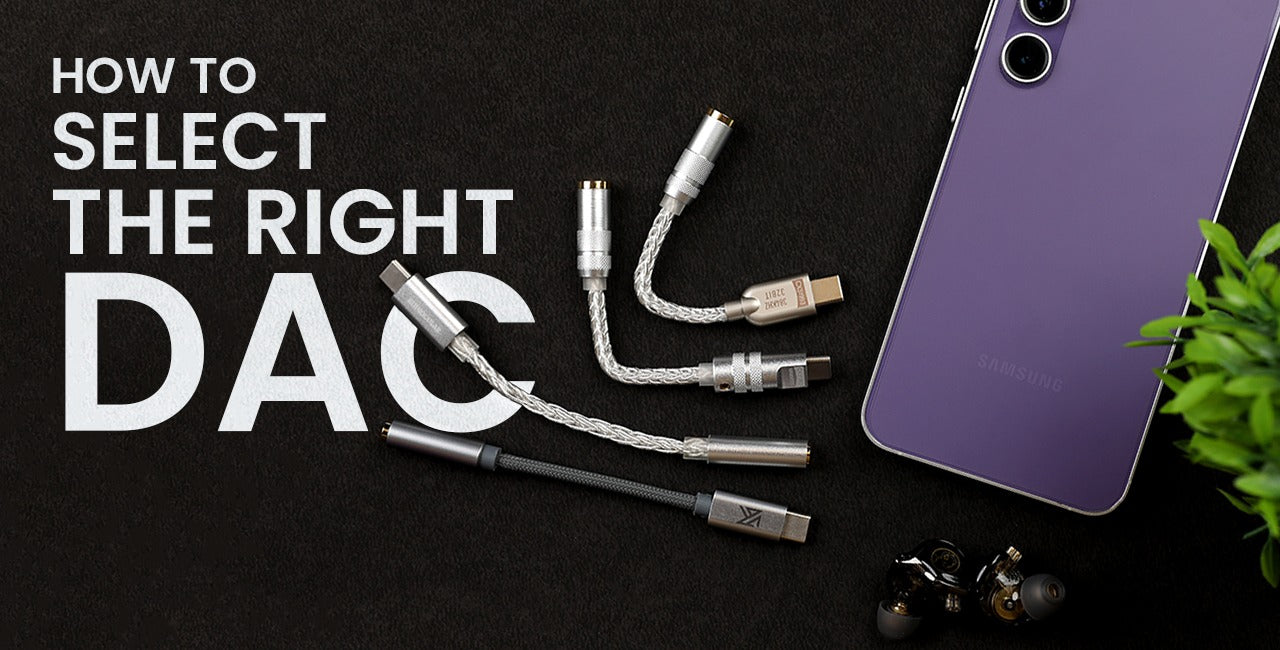HOW TO SELECT THE RIGHT DAC: KEY CONSIDERATIONS FOR MUSIC ENTHUSIASTS

When choosing a Digital-to-Analog Converter (DAC) for your audio setup, it’s essential to understand some core specifications and performance metrics that define the sound quality you’ll experience. Metrics like Dynamic Range (DNR), Signal-to-Noise Ratio (SNR), and Total Harmonic Distortion (THD) are fundamental, as they determine the clarity, detail, and fidelity of your music. Here’s a breakdown of these terms and tips on what to consider when selecting a DAC to enhance your listening experience.
1. Dynamic Range (DNR)
Dynamic Range (DNR) measures the difference between the softest and loudest sound that a DAC can reproduce without distortion. A high dynamic range translates to a more detailed and nuanced sound, especially during low-level passages.
-
Why It Matters: In a DAC, DNR is crucial because it determines how much detail can be extracted from the original recording. A high DNR ensures quiet sections of music remain clean without being masked by noise.
-
What to Look For: Aim for DACs with a dynamic range of at least 110 dB. For audiophile-grade equipment, look for DNR values of 120 dB or higher. Higher values indicate better clarity and less background noise, so complex orchestral or live recordings will sound more vivid and immersive.
2. Signal-to-Noise Ratio (SNR)
The Signal-to-Noise Ratio (SNR) measures how much of the audio signal is retained above the inherent noise floor. In simpler terms, it’s the ratio of useful sound (signal) to unwanted noise.
-
Why It Matters: A higher SNR value means less interference from background noise, resulting in clearer and cleaner sound, especially at high volumes.
-
What to Look For: DACs with an SNR above 90 dB are generally good for casual listening, but for high-fidelity audio, you’ll want an SNR of 110 dB or more. High SNR is particularly important for studio environments and critical listening sessions, where you want minimal noise interference.
3. Total Harmonic Distortion (THD)
Total Harmonic Distortion (THD) quantifies the distortion that the DAC introduces into the audio signal. This distortion occurs as the DAC reproduces sound, and while some harmonic distortion can be negligible, higher levels are undesirable.
-
Why It Matters: Lower THD values indicate cleaner, more accurate sound. High THD can make music sound muddy or smeared, impacting instrument separation and overall clarity.
-
What to Look For: Look for DACs with a THD rating of 0.001% or lower. Lower THD becomes especially important in high-fidelity audio setups where you want a pure and undistorted reproduction of the recording.
4. Bit Depth and Sampling Rate
While not directly related to DNR, SNR, or THD, the bit depth and sampling rate of a DAC are critical to its performance. The bit depth impacts the dynamic range, while the sampling rate affects how accurately the DAC can reproduce higher frequencies.
-
Why It Matters: A higher bit depth allows for a wider dynamic range, and a higher sampling rate supports accurate reproduction of high-frequency content.
-
What to Look For: For most use cases, a DAC with 24-bit depth and a sampling rate of 192 kHz is more than sufficient. For high-resolution audio enthusiasts, 32-bit DACs with sampling rates up to 384 kHz offer even greater fidelity.
5. Output Impedance and Connectivity
Output impedance is crucial when pairing a DAC with amplifiers or headphones. A mismatch can lead to frequency response issues, compromising sound quality.
-
Why It Matters: A DAC with a high output impedance may struggle to drive low-impedance headphones or amplifiers without distortion.
-
What to Look For: Look for DACs with an output impedance lower than 2 ohms to maintain sound fidelity across various headphones or speaker pairings.
6. Additional Features
Many modern DACs come with extra features that can enhance their usability:
-
Balanced Outputs: Balanced XLR outputs can reduce noise, making them ideal for professional setups.
-
Built-In Amplification: DACs with an integrated amplifier can be more convenient for driving headphones or speakers directly.
-
USB and Bluetooth Connectivity: For added flexibility, choose a DAC with multiple connectivity options, including USB and Bluetooth, to accommodate different devices.
Choosing the Right DAC for Your Setup
-
Casual Listening: For general home use, look for a DAC with at least a 100 dB SNR and 24-bit/96 kHz resolution. It’ll offer quality sound without overspending on features that casual listeners may not notice.
-
Audiophiles and Critical Listeners: If sound purity and detail retrieval are priorities, consider DACs with at least a 120 dB DNR, low THD (<0.001%), and balanced outputs. A higher bit depth and sampling rate are recommended for high-resolution audio files.
-
Professional Studio Use: For studios, accuracy is paramount. Choose a DAC with very high SNR, low THD, and balanced outputs. Look for detailed specifications on impedance matching to ensure compatibility with a wide range of equipment.
CONCLUSION
When selecting a DAC, prioritize metrics like DNR, SNR, and THD, as they directly affect sound quality. Additionally, consider the bit depth, sampling rate, impedance, and connectivity options to match your setup. By carefully evaluating these aspects, you can choose a DAC that meets your needs and upgrades your listening experience to its fullest potential.
DAC Recommendations by Price Range (Including Best-Selling Models)
Under ₹1,000: Audiocular D07, Audiocular D10
Under ₹2,000: Audiocular D08, Audiocular D11
Under ₹5,000: Blon V1, Shanling UA Mini
Under ₹10,000: Kinera Celest CD-20, Roseselsa RS9039
Under ₹20,000: Fosi Audio V3, Shanling UA6
Under ₹30,000: Arylic H50, S.M.S.L RAW MDA1
Under ₹50,000: HiBy FD5, Luxury & Precision W2 Ultra
Under ₹1,00,000: xDuoo XD05T, Shanling H7
Above ₹1,00,000: Gustard X30, Shanling Onix Mystic XP1
These options cater to casual listeners, audiophiles, and professionals across all budgets!














